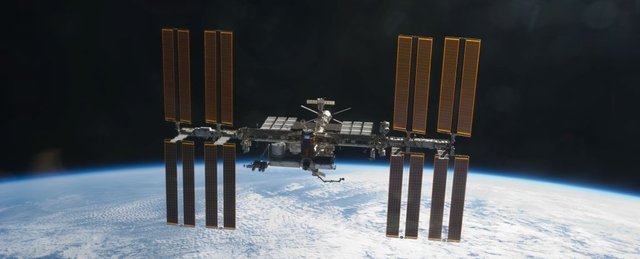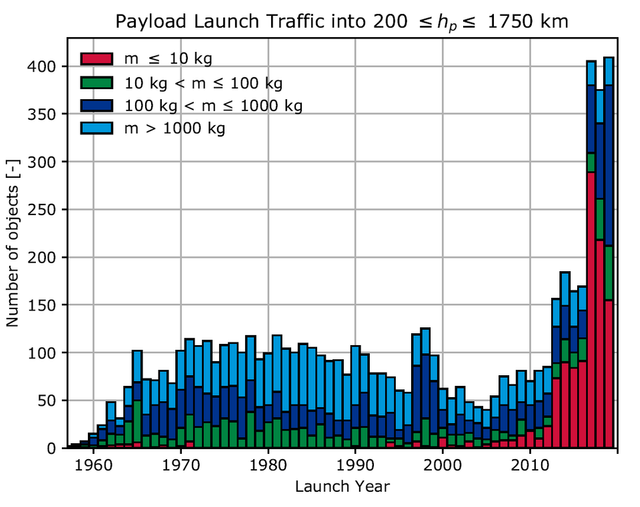A problem on the International Space Station
The Canadian Space Agency (CSA) and National Aeronautics and Space Administration (NASA) announced on Friday May 28, 2021 that a small hole had been discovered on May 12 in a fixture of the International Space Station (ISS) called Canadarm2. Some news outlets have characterized the issue as having been the result of orbital space junk. Indeed, fragments of material from prior space missions and satellite launches have left a large area and mass of dangerous debris that have the potential to cause problems for equipment currently in orbit. This mass of debris can be the result of collisions, explosions, electrical problems, and detaching equipment that suffers an unintended fate due to the hazardous conditions of space.
Some outlets note that the source and composition of the debris is unknown. There are natural fragments of rock that create risk of collision in Earth orbit, too.
(June 01, 2021; from Insider)
In total, nearly 130 million pieces of debris crowd Earth's orbit ... The chunks zip around the planet at more than 17,500 mph, roughly 10 times the speed of a bullet.NASA and other space agencies keep tabs on more than 23,000 known pieces of space debris that could threaten the space station — pretty much anything larger than a softball. If there's more than a 1-in-100,000 chance of a collision, NASA will maneuver the ISS out of harm's way, since a collision could endanger the lives of the astronauts on board.
What are the implications for the International Space Station, and its Canadarm2 robotic arm?
Canadarm2 is—you may have guessed— the second in a series of robotic arms designed by the CSA for use in cooperation with NASA. The first Canadarm was in operation on NASA space shuttles from 1981-2011, and Canadarm2 was deployed to the ISS in 2001. Overall, the Canadian contribution to the ISS includes two (2) innovative robotic elements, Canadarm2 and Dextre, and the Mobile Base System (MBS), which functions as a power conduit and transport system for the robots. The MBS is mounted on a Mobile Transporter that allows the MBS to move itself and the two robots to any of 8 different workstations by way of the main truss on the ISS.
Dextre is an advanced robot with a human-like sense of touch and more complex movements than a human arm; Dextre's seven (7) joints, each with a full range of motion to move up, down, side to side, and rotate give it the dexterity that allows it to do its work. Work for Dextre includes repairing, installing or replacing equipment outside the ISS. It has even repaired itself, the only space robot to have done so. Scientists also use Dextre to test new techniques and tools that could enable better service for satellites in space in the future. Dextre is controlled from Earth to manipulate objects as small as safety caps and wires, and its work can be directed with a precision of down to a few millimeters! With the capability to handle small items at such precision, or items as large as a refrigerator, Dextre works mostly while its human companions on the ISS are asleep, and reduces the need for risky and dangerous space walks. This is the most sophisticated robot ever designed for work on space objects like the ISS.
After CSA's and NASA's evaluation of detailed images of the area of Canadarm2's boom segment where the heat cover, the space agencies determined that operations will continue as planned. Next up: Dextre will be repositioned in order to replace a faulty power switchbox.
Long term effects, and mitigation
This isn't the first time sensitive equipment has been punctured by orbital debris. The Hubble Space Telescope antenna was punctured in 1997, and the ISS must routinely avoid collisions with space debris.
(September 23, 2020; From Science Alert)

This type of maneuver is necessary on a regular basis. NASA said 25 such maneuvers had occurred between 1999 and 2018.
Debris is getting worse. Naturally, there is a plan to mitigate the dangers. In addition to the tracking of many thousands of the larger pieces of debris, the European Space Agency is working on debris prevention measures with a Space Safety Programme. Guidelines have been put in place to clarify how a sustainable use of space can be achieved: minimize "shedding" with better spacecraft design; reduce explosions by managing end of life of spacecraft, and engineering better ways to handle stored energy; de-orbit equipment once it can no longer be utilized, or move it to a safe orbit; choose orbits properly, and apply maneuvering tactics to avoid collisions.
For now, we're making more debris, and the trend of accidental fragmentations is increasing. However, space agencies have begun to become compliant with international guidelines, with successful attempts to comply with mitigation measures increasing over the last 20 years. The rate of adoption for these compliance efforts needs to continue to increase, and must do so more quickly in order for our space programs to become compliant quickly in order to reduce the risk of catastrophic events.
Helpfully, successful attempts to dispose of rocket bodies specifically has seen a significant increase over the past 20 years. Since rocket bodies are some of the largest objects sent to space, and are at high risk for collision, this is critical to sustainable space utilization. Within the last decade, almost all satellites launched into geostationary orbit—the type of orbit where a satellite remains in one place above the Earth—saw attempts to move out of harms way. The past few years have been marked with a substantial increase in the placement of small satellites in low-Earth orbit. Due to their low orbit, these pieces of equipment tend to burn up in the Earth's atmosphere when they de-orbit, or if they experience any shedding or collision events.
Compared to a decade ago, adoption of debris mitigation tactics by space agencies has fortunately increased. Moving forward, it is critical that adoption of these measures, and adherence to international standards around orbit management, spacecraft design, and equipment disposal continues to grow if we are to continue to benefit scientifically and technologically from our missions in space.
The future of space missions

(December 10, 2020; From the European Space Agency)
ESA is actively working to support the guidelines for the long-term sustainability of outer space activities from the UN Committee on the Peaceful Uses of Outer Space, including funding the world’s first mission to remove a piece of debris from orbit, helping to create an international space sustainability rating and developing technologies to automate collision avoidance and reduce the impact on our environment from space missions.
Our space agencies, and the entities that guide international cooperation by and between them need to continue to work toward sustainable space use practices. We seem to be headed in the right direction, so we can hope to avoid Kessler syndrome, where a chain reaction of collisions due to an unsustainable density of low-Earth objects would render certain orbits unusable altogether. If our space agencies successfully mitigate this risk, we can count on outer space being the next frontier rather than the final junkyard.
Would you like to attempt an ISS mission using partly the same robotics simulator the CSA headquarters uses to train astronauts? Check out* https://www.asc-csa.gc.ca/eng/multimedia/games/canadarm2/default.asp to run a virtual robotics mission with you in control of Canadarm2!
- Please note that you may want to take precautions when downloading, installing, or running the Unity Web Player.
Sources for this write up:
- https://www.businessinsider.com/space-debris-hit-international-space-station-damaged-robotic-arm-2021-6
- https://www.asc-csa.gc.ca/eng/iss/news.asp
- http://www.esa.int/Safety_Security/Space_Debris/The_current_state_of_space_debris
- https://www.space.com/space-station-robot-arm-orbital-debris-strike
- ...and linked pages from the above list
Space debris as the article says is a danger for the space station and for astronauts since this debris travels 10 times faster than the speed of a bullet here on earth, recently we lived the case of the space shuttle that had about to be hit by an object, but thanks to the sensors it could be detected two 2 hours before the impact, otherwise the astronauts would experience a great tragedy.
About the Dextre robotic arm, it is good that the astronauts have this very useful tool, because going into space and repairing something manually would be a fixed double weapon since they are willing to lose their life if it is hit by a screw or any other type of garbage. that travels an average speed of 25 thousand Kilometers per hour.
I have a question and curiosity !!
Are you Steve and Christopher's family?
Downvoting a post can decrease pending rewards and make it less visible. Common reasons:
Submit
Thank you for the comment! I am sure the astronauts appreciate being able to stay inside and rest while the robot does repair work so they can minimize risk to themselves!
Downvoting a post can decrease pending rewards and make it less visible. Common reasons:
Submit
Yes! Hi.
I am Steve's brother. Nice to connect with you.
Downvoting a post can decrease pending rewards and make it less visible. Common reasons:
Submit
It is a pleasure to meet you, I hope to have a lasting friendship here on steemit with you and continue reading your post, which by the way these types of topics fascinate me to talk about astrophysics and the mystery of the universe, although here you talked about how dangerous space can be for the astronauts.
Downvoting a post can decrease pending rewards and make it less visible. Common reasons:
Submit
It fascinates me too. Maybe we should try to get an astronomy community started.
Downvoting a post can decrease pending rewards and make it less visible. Common reasons:
Submit
That idea sounds great, I could run as a community moderator :-) but there is a problem that all communities face.
You and I do not have the necessary steempower to compensate all users who want to share their content in the community, so a sponsor would be missing.
Downvoting a post can decrease pending rewards and make it less visible. Common reasons:
Submit
Yes, I have been contemplating how to get sponsors involved in order to start building some communities. It is a hurdle for sure.
There is a better chance of success by trying. : )
Downvoting a post can decrease pending rewards and make it less visible. Common reasons:
Submit
Well .. let's get to work where we started.But later since it is 12:04 am in my country and I am going to sleep my discord is Ruzmaira#8537 just in case you want to contact me
Downvoting a post can decrease pending rewards and make it less visible. Common reasons:
Submit